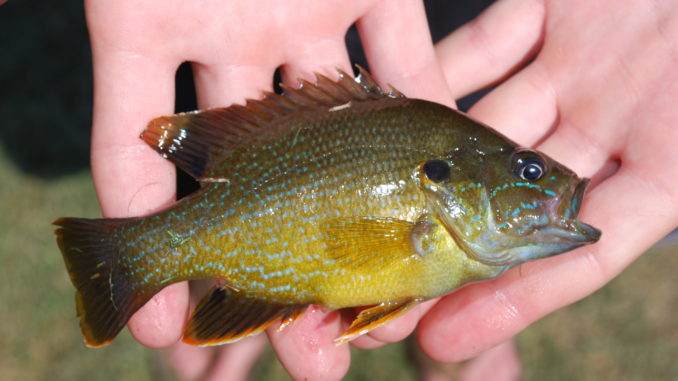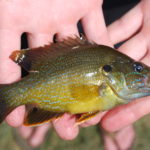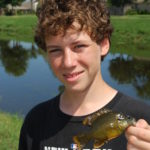
Green sunfish aren’t very particular
Sometimes we can’t help but assign human traits to other creatures, no matter how scientifically incorrect it is. So it is with the green sunfish, Lepomis cyanellus. One scientific guidebook says that the green sunfish is “especially promiscuous and indiscriminate.”
To say the least!
Sixteen members of the sunfish genus Lepomis exist in the United States, 10 in Louisiana. The green sunfish will mate and hybridize with every one of them. It’s a wonder that the fish even exists as a species anymore and hasn’t bred itself out of existence.
Middling in size for sunfish (or bream or perch, as the group is usually called in Louisiana), the world record is 2 pounds, 2 ounces. Compare that to 4 pounds, 10 ounces for bluegill or 5 pounds, 7 ounces for redear sunfish.
Most references list the species as common, and it is listed as statewide in occurrence in Louisiana. But a very large percentage of anglers have never seen one. They seldom turn up in mixed bream catches of bluegills, redears (chinquapin), goggleyes, longears (sun perch) or spotted sunfish.
Part of this may be due to the fact that they are more specialized in their habitat choices than is often recognized. One place that they seem to do well is small, clear-water, sandy-bottom creeks, which they share only with longear sunfish. Bluegill are seldom present in these habitats.
The other habitat that seems to suit them to a tee are small ponds, especially those newly formed. They are a pioneer species, along with bullheads (pollywogs or mudcats) in that they seem to appear out of nowhere in formerly fishless waters. Their appearance without help of man or flooding by other waters has inspired a bunch of theories on how they get to these isolated waterbodies.
But once there, with no competition from other bream, they thrive, so well in fact they form huge populations of small stunted fish 2 to 3 inches long, perfect bait size for big predatory fish like flathead catfish. This, coupled with their hardiness (they seem to live forever on a hook), has prompted knowledgeable trot liners to stock their own private ponds with only this species, which they call “slick perch” or “slicks.”
A small pond will produce a seemingly endless supply of bait — until bluegill or bass invade. When bluegills are introduced, they rapidly begin to hybridize with the green sunfish, and in a few generations, green sunfish genes seem to disappear. Many a good green sunfish bait pond has been ruined by the well-meaning introduction of bluegills.
Introduced bass don’t hybridize with green sunfish. They just eat them like popcorn.
In body shape (elongated) and mouth size (big) they resemble goggleyes more than they do other perch. But they are not nearly as colorful as goggleyes, never showing the red or reddish-brown eyes of their bigger cousin.
Their body overall is generally greenish and covered with blue dots arranged in lengthwise rows. Broken blue bars are also found on the cheeks below the eyes. The cyanellus part of their name means “blue” in Latin.
Like other members of the sunfish family, which includes black bass, green sunfish spawn in nests produced by the male sweeping a spot clean on the bottom with his tail. Nests may be in colonies or they may be singles. Once a male has constructed the nest, he becomes extremely aggressive, chasing off other males and any fish that may eat their spawn.
Males apparently court females by swimming out to meet them and then returning to the nest, producing a series of unique grunts. Apparently, the sounds are attractive not only to female green sunfish but other sunfish species as well, considering the number of hybrids.
Any young produced by green sunfish crossing with other species, be they bluegills, redears, longears or goggleyes, have an appearance halfway between the two parent species.
Some authorities list hybrids as being perfectly fertile. Others report that they are mostly male and seldom reproduce in the wild. If the latter is the case, it may explain why bluegills introduced into a green sunfish pond will come to dominate it. Bluegill to bluegill matings produce actively fertile young. Bluegill to green sunfish matings don’t.
In further support of the theory that bluegill-green sunfish hybrids are not reproductively successful, breeders have produced deliberate hybrids by crossing female green sunfish with male bluegills to stock in ponds for “put and take fisheries.” The hybrids grow faster than either parent species and, like their green sunfish parent, they are aggressive and greedy feeders, attacking anything vaguely edible and small enough to get in their large mouths.
These fish are marketed under the name “hybrid bream” along with extravagant claims about their productivity in pond environments.




